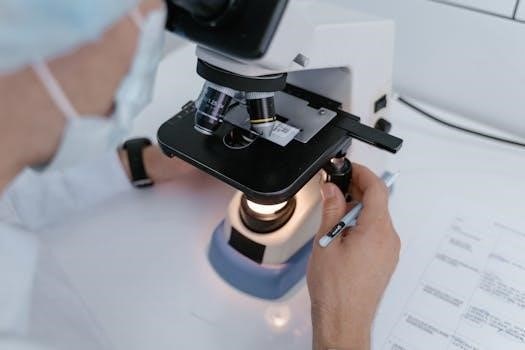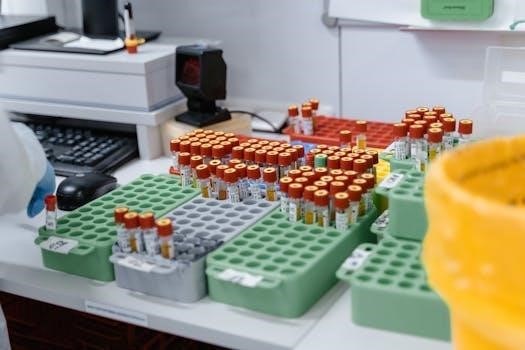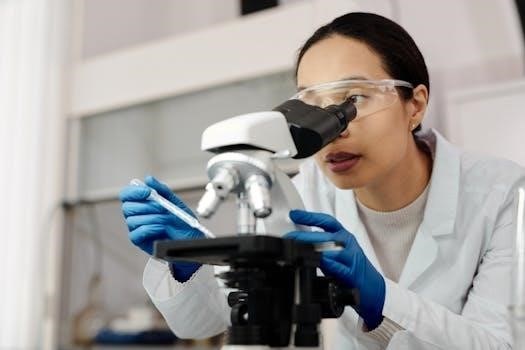
laboratory manual for general biology

Title⁚ Laboratory Manual for General Biology⁚ A Comprehensive Guide
This comprehensive laboratory manual serves as an essential guide for students in general biology courses․ It offers hands-on experiments, covering various topics like microscopy, cell biology, genetics, evolution, and ecology, providing a modern approach for learning․
This laboratory manual is designed as a practical companion to your general biology studies, aiming to enhance understanding through hands-on experimentation․ It provides a structured approach to learning core biological principles, offering a series of exercises that move from basic concepts to more complex investigations․ The manual integrates modern techniques, ensuring a relevant and engaging educational experience․ Each experiment is carefully designed to reinforce theoretical knowledge with practical application․ It includes clear procedures, safety guidelines, and opportunities for data analysis and interpretation․ This resource is crafted to support students in achieving essential academic skills and preparing for future studies in biological sciences․ This manual serves as an indispensable tool for your laboratory work․
Safety Procedures and Guidelines
Ensuring a safe laboratory environment is paramount for all experiments․ This section outlines crucial safety procedures and guidelines․ Always wear appropriate personal protective equipment, including safety goggles and gloves․ Handle all biological materials with care, following specific instructions for disposal and decontamination․ Be aware of the location of emergency equipment, such as eyewash stations and fire extinguishers․ Never eat, drink, or apply cosmetics in the lab․ Immediately report any spills or accidents to your instructor․ Proper waste disposal is essential to prevent contamination and maintain a clean workspace․ Adherence to these safety protocols is mandatory and ensures a secure and effective learning environment for all participants in the lab․ Your cooperation is greatly appreciated․
General Lab Safety Rules
Adhering to general lab safety rules is crucial for a secure and productive learning environment․ Always wear appropriate personal protective equipment, including safety goggles and gloves, when handling any chemicals or biological specimens․ Keep the lab area tidy and free from clutter to prevent accidents․ Never engage in horseplay or unauthorized experiments․ Understand the proper use and disposal of all materials, especially biological ones․ Report spills, breakages, or any incidents to your instructor immediately․ Familiarize yourself with the location of safety equipment․ Avoid eating or drinking in the lab․ These practices must be followed to ensure a safe and effective learning experience for everyone involved․ Your cooperation is essential․

Handling of Biological Materials
The proper handling of biological materials is critical for safety and experiment integrity․ Always treat all biological specimens as potentially hazardous and wear gloves․ Use appropriate tools for handling specimens, avoiding direct contact with skin․ Dispose of biological materials in designated containers, following strict waste protocols․ Be aware of potential biohazards and never conduct unauthorized experiments․ If you come into contact with any biological material, wash your hands thoroughly with soap and water․ Report any accidental spills or exposures immediately to your instructor․ Understand the importance of aseptic techniques to prevent contamination․ Your adherence to these guidelines is crucial for safe and effective experiments․
Microscopy Techniques
Microscopy is a fundamental skill in biology, enabling us to observe structures not visible to the naked eye․ This section introduces the principles and techniques of using microscopes․ We’ll focus on compound microscopes, learning their parts and proper handling․ Students will master focusing techniques and adjusting illumination for optimal viewing․ Proper slide preparation is also important, ensuring clear and accurate observation of specimens․ Through hands-on practice, students will become proficient in using microscopy to explore the intricate world of cells and microorganisms․ Learning these skills is crucial for understanding biological structures and processes․

Using Compound Microscopes
The compound microscope is a crucial tool for biological studies, allowing detailed examination of minute specimens․ This section provides a step-by-step guide to its correct usage․ We will begin by identifying and understanding the function of each component, including the objective lenses, stage, condenser, and focusing knobs․ Students will learn to properly mount slides and focus under low power before advancing to higher magnifications․ Correct illumination and image adjustments are also emphasized․ This mastery of the compound microscope is essential for the subsequent cell biology and microbiology experiments․
Preparing Slides
Proper slide preparation is fundamental for accurate microscopic observation․ This section details the techniques required to prepare both wet mount and dry mount slides․ Students will learn how to handle cover slips to avoid air bubbles, and understand the importance of using appropriate staining techniques to enhance visualization of cellular structures․ Specific instructions will be given for preparing slides from various biological specimens, including plant cells, animal tissues, and microorganisms․ This essential skill ensures clear, high-quality images, crucial for conducting accurate scientific investigations․ Additionally, students will be taught how to dispose of slides safely․
Cell Biology Experiments
This section provides a series of hands-on experiments designed to explore fundamental concepts in cell biology․ Students will engage in activities such as observing various cell types, and understanding cellular processes through direct experimentation․ The experiments include detailed protocols for conducting microscopic analysis and biochemical assays․ These exercises will emphasize the importance of cell structure and function, which is crucial for understanding how living organisms work․ Students will learn through direct experience, improving their scientific reasoning and laboratory skills․ We will also explore the cell cycle, mitosis, and cell differentiation in this section․
Onion Cell Observation
This experiment focuses on the microscopic observation of onion cells, a classic exercise in cell biology․ Students will learn how to prepare a wet mount slide of an onion epidermis․ They will then use compound microscopes to observe and identify various cellular structures, such as the cell wall, nucleus, and cytoplasm․ This exercise provides an excellent opportunity to understand basic cell anatomy․ Detailed instructions are provided for slide preparation and microscope usage, ensuring that students can easily follow the steps․ Students will also have the opportunity to make drawings and label cellular components during their observations․
Genetics and Heredity
This section explores the fundamental principles of genetics and heredity․ Students will delve into concepts such as Mendelian inheritance, Punnett squares, and the role of chromosomes in passing on traits; We will examine how genetic information is transmitted from one generation to the next․ The laboratory exercises will provide hands-on experience in simulating genetic crosses and interpreting the results․ This will further enhance understanding of basic genetic concepts․ Furthermore, we will explore the concept of dominant and recessive genes, alongside the influence of various alleles on phenotypes․ Through these experiments, students will grasp the importance of heredity․
Basic Genetics Experiments
This section focuses on core experiments designed to illustrate fundamental concepts in genetics․ Students will perform monohybrid and dihybrid crosses using simulated organisms to observe the patterns of inheritance firsthand․ Through these activities, they will learn to construct Punnett squares, predict genotypic and phenotypic ratios, and analyze experimental data․ These exercises reinforce understanding of Mendelian principles․ They also highlight the link between genotypes and observable traits․ Students will learn how to analyze experimental results and draw conclusions based on the genetic principles they have learned․ The experiments provide a practical approach to grasping complex genetic ideas․
Evolutionary Concepts
This section explores foundational concepts in evolutionary biology, including natural selection, genetic drift, and adaptation․ Students will engage in activities that simulate evolutionary processes, demonstrating how populations change over time․ Emphasis will be placed on understanding the evidence for evolution, such as fossil records and comparative anatomy․ Exercises will also cover phylogenetic tree construction, illustrating the relationships among different organisms․ These activities help students grasp the mechanisms driving evolutionary change and the evidence supporting the theory of evolution․ Students will also discuss case studies of evolution in action, applying the principles to real-world examples․ This section aims to provide a comprehensive view of evolutionary concepts․
Human Anatomy and Physiology
This section provides an overview of human anatomy and physiology, focusing on the major organ systems․ Students will learn about the structure and function of the skeletal, muscular, nervous, circulatory, respiratory, digestive, and excretory systems․ The experiments will include examining anatomical models, conducting basic physiological measurements, and analyzing the relationships between different organ systems․ Students will also explore how these systems work together to maintain homeostasis․ This section will introduce the fundamental concepts of human biology, equipping students with a basic understanding of the human body․ The aim is to provide an engaging and educational experience in human anatomy and physiology․
Ecology and Environmental Studies
This section of the laboratory manual focuses on ecological principles and environmental issues․ Students will explore topics such as population dynamics, community interactions, and ecosystem structure․ The included lab exercises will involve simulations, data collection, and analysis of real-world ecological data․ Students will also learn about various environmental challenges, including pollution, habitat destruction, and climate change․ This will include conducting field studies to assess biodiversity and analyze environmental impacts․ The section will emphasize the importance of conservation and sustainable practices to protect the environment․ The goal is to develop students’ understanding of ecological relationships and environmental responsibility, preparing them to be informed citizens․
Field Study Techniques
This section introduces essential field study techniques for ecological investigations․ Students will learn methods for sampling populations, measuring environmental parameters, and assessing biodiversity․ Techniques covered will include quadrat sampling, transect surveys, and mark-recapture methods for studying animal populations․ Students will also learn how to use various field equipment, such as GPS devices, data loggers, and water quality testing kits․ Proper data collection methods and safety protocols in the field will be emphasized․ This section will provide opportunities to analyze field data to explore ecological patterns and relationships․ The exercises will enhance students’ practical skills in ecological research and environmental monitoring․
Data Analysis and Scientific Research
This section focuses on the principles of data analysis and scientific research within a biological context․ Students will learn how to organize, analyze, and interpret data collected from experiments and field studies․ The section will cover descriptive statistics, such as mean, median, and standard deviation, as well as basic inferential statistics․ Students will also explore hypothesis testing and how to draw meaningful conclusions from data․ Emphasis will be placed on the importance of accurate record-keeping, data visualization, and the use of statistical software․ This will also cover the process of designing experiments, formulating hypotheses, and analyzing results․ This practical approach will help develop essential skills for conducting scientific research․

Data Collection and Interpretation
This subsection delves into the crucial steps of data collection and interpretation, essential for any scientific endeavor․ It emphasizes the importance of meticulous and accurate data recording during experiments and field studies․ Students will learn various methods of data collection, including quantitative and qualitative techniques, and how to select appropriate methods for specific research questions․ The focus shifts to interpreting data through statistical analysis, identifying trends, and drawing valid conclusions based on evidence․ This section will also address the importance of visualizing data using graphs and charts to present findings․ Students will learn to distinguish between correlation and causation and understand the limitations of data․
Lab Report Writing
This section provides a detailed guide on how to write a comprehensive and well-structured lab report, a vital skill for communicating scientific findings․ It covers all essential components of a lab report, including the title, abstract, introduction, materials and methods, results, discussion, and conclusion․ Emphasis is placed on clear and concise writing, using proper scientific terminology, and accurate data representation․ Students will learn the importance of citing sources and avoiding plagiarism․ This guide also offers tips for analyzing experimental data and presenting it effectively within the report․ Understanding the purpose of each section will be key to mastering effective scientific communication․
Additional Resources and Appendix
This section offers supplementary materials to enhance your understanding of the concepts and techniques covered in the manual․ Here, you will find a compilation of useful resources including websites, journal articles, and relevant books for further reading․ An appendix is included with additional information, such as a glossary of key terms, conversions and formulas, and detailed protocols for specific experiments․ This section aims to provide comprehensive support and access to valuable reference materials which will aid in learning and research․ It also includes safety guidelines and emergency protocols in more detail․ This provides extra information for those students who want to deepen their understanding further․